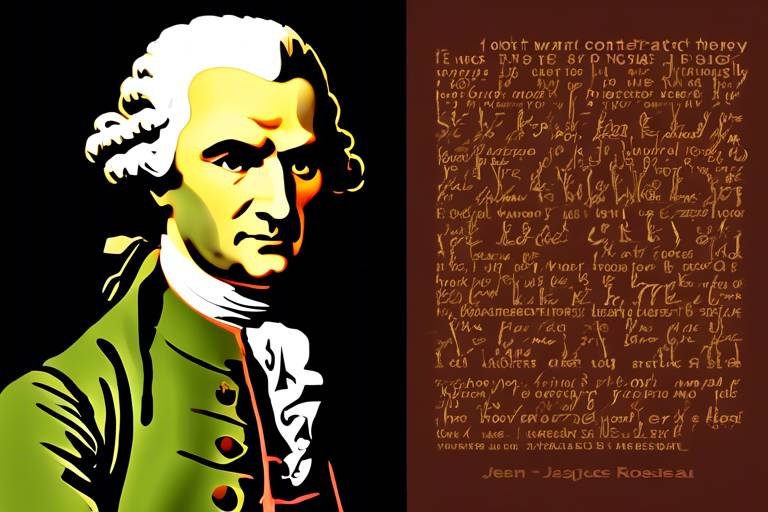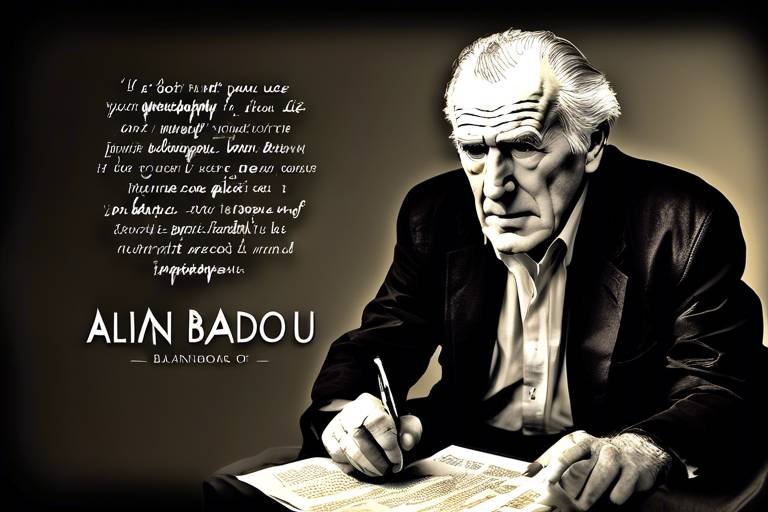An Insight into Charles Sanders Peirce's Pragmatism
Welcome to the fascinating world of Charles Sanders Peirce and his groundbreaking philosophy known as pragmatism. If you’ve ever wondered how our understanding of truth and meaning is shaped by practical consequences, then you’re in for a treat! Peirce, often hailed as the "father of pragmatism," proposed a unique approach that not only challenged traditional philosophical ideas but also laid the groundwork for modern scientific inquiry. His work is not just a relic of the past; it’s a living, breathing framework that continues to influence various fields today. So, let’s dive into the core principles of Peirce’s pragmatism and discover how they emerged as a response to the philosophical challenges of his time.
At its heart, pragmatism is all about action and results. Peirce believed that the meaning of a concept is intrinsically tied to its practical implications. Imagine you’re trying to understand what “truth” really means. Instead of getting lost in abstract definitions, Peirce would encourage you to consider how that truth plays out in real-life situations. It’s like trying to grasp the concept of “freedom” without considering what it means to live freely in society. This emphasis on practical consequences is what sets pragmatism apart from other philosophical doctrines.
Peirce’s ideas didn’t just pop up out of nowhere. They were a response to the philosophical landscape of the 19th century, which was rife with skepticism and a focus on absolute truths. Peirce saw the limitations in these approaches and sought to create a philosophy that embraced the fluidity of human experience. By doing so, he opened the door to a more dynamic understanding of knowledge, one that values experimentation and real-world applications over static definitions.
As we explore Peirce's pragmatism, we’ll discover how his concepts have transcended philosophy and seeped into the realms of science, language, and communication. His work on semiotics, which is the study of signs and symbols, provides a rich framework for understanding how we convey meaning in our everyday lives. In essence, Peirce's pragmatism is not just a philosophical stance; it’s a toolkit for navigating the complexities of reality. So, grab your thinking cap as we unravel the intricacies of his thought and examine how they continue to resonate in our modern world.
In this section, we will delve deeper into the core principles of pragmatism, highlighting how Peirce's ideas emerged as a response to philosophical challenges and the significance of practical consequences in understanding truth.
- What is pragmatism? Pragmatism is a philosophical approach that evaluates theories or beliefs in terms of the success of their practical application.
- Who is Charles Sanders Peirce? Peirce was an American philosopher, logician, mathematician, and scientist, known for his work in semiotics and pragmatism.
- How does Peirce's pragmatism influence modern philosophy? Peirce's pragmatism has influenced various contemporary philosophical movements, including those led by William James and John Dewey, by emphasizing the importance of practical consequences in understanding concepts.

The Foundations of Pragmatism
Pragmatism, as conceived by Charles Sanders Peirce, is not just a philosophical stance; it is a dynamic approach to understanding the world around us. Peirce's pragmatism emerged as a response to the rigidities of metaphysical speculation, offering a refreshing alternative that emphasizes the importance of practical consequences in determining truth. This philosophy invites us to consider how our beliefs and ideas manifest in real-world applications, thereby grounding abstract concepts in tangible experiences.
At its core, pragmatism is about action and the outcomes of our thoughts. Peirce famously stated that the meaning of a concept lies in its practical implications. This means that rather than getting bogged down in theoretical debates, we should focus on how our ideas can be tested and applied in everyday life. For instance, when we think about truth, Peirce encourages us to ask: “What practical difference would it make if this belief were true?” This question shifts the focus from abstract reasoning to real-world impact, making philosophy relevant and accessible.
Peirce's pragmatism also serves as a powerful tool for navigating philosophical challenges. In a world filled with uncertainty and conflicting ideas, pragmatism provides a framework that prioritizes adaptability and evolution of thought. Instead of clinging to static definitions, pragmatists embrace the idea that our understanding of truth can change as we gather more experiences and evidence. This fluidity is crucial, especially in an age where information is constantly evolving.
Moreover, Peirce’s insistence on the significance of community in shaping beliefs cannot be overstated. He believed that our understanding of truth is not solely an individual endeavor but is deeply rooted in social interactions and collective experiences. This communal aspect of pragmatism encourages dialogue and collaboration, fostering a rich environment for intellectual growth. When we share our experiences and insights with others, we refine our beliefs and enhance our understanding of the world.
In summary, the foundations of Peirce's pragmatism rest on the principles of practical consequences, adaptability, and the social nature of knowledge. By prioritizing what works in practice over what is theoretically sound, pragmatism offers a robust framework for navigating the complexities of life. It invites us to engage with the world actively, testing our ideas and beliefs against the realities we encounter, thereby enriching our understanding and fostering a more meaningful existence.

Charles Sanders Peirce, often referred to as the "father of pragmatism," introduced a revolutionary way of understanding how we communicate and derive meaning through what he termed "signs." At the heart of his semiotic theory lies the intricate relationship between signs, objects, and interpretants. In simpler terms, a sign is anything that represents something else, and understanding this triadic relationship is crucial for grasping the essence of communication. Peirce believed that the way we interpret signs is not just a matter of personal perception but is deeply rooted in the practical consequences of those signs in our everyday lives. This perspective emphasizes that meaning is not static; rather, it evolves through interaction and experience.
To break it down further, Peirce categorized signs into three distinct types, each playing a unique role in the process of meaning-making:
- Icons: These are signs that resemble their objects. Think of a photograph; it looks like the person or scene it depicts, making it an iconic representation.
- Indices: These signs have a direct connection to their objects. For example, smoke is an index of fire; where there’s smoke, there’s likely a fire.
- Symbols: Unlike icons and indices, symbols derive their meaning from social conventions. Words in a language are symbolic signs; their meanings are agreed upon by the speakers of that language.
Understanding these types of signs is essential because they illustrate how we navigate the complexities of communication. For instance, when we see a stop sign on the road, we recognize it as a symbol that conveys a specific meaning based on societal agreement. However, if we were to encounter a red light in a different context, our interpretation might shift, showcasing the fluidity of meaning based on the signs’ context.
Peirce's exploration into signs goes beyond mere classification; it invites us to consider how we construct knowledge and understanding through these signs. His semiotic framework lays the groundwork for analyzing how meaning is created and shared, making it a vital aspect of pragmatism. By acknowledging the dynamic interplay between signs and their interpretations, we can appreciate the depth of communication and the significance of context in our understanding of the world.
In essence, Peirce's concept of signs not only enhances our comprehension of language but also enriches our understanding of human interaction and thought. The implications of his semiotic theory extend into various fields, including linguistics, philosophy, and even artificial intelligence, where the interpretation of signs is crucial for developing effective communication systems.
As we delve deeper into Peirce's ideas, we realize that his insights into signs are not just academic; they resonate with our daily experiences. Every conversation, every piece of art, and every written word is a negotiation of meaning, shaped by the signs we use and the contexts we inhabit. Understanding this can transform how we engage with the world around us, making Peirce's contributions to pragmatism profoundly relevant today.
- What is the significance of Peirce's semiotic theory? Peirce's semiotic theory is significant because it provides a framework for understanding how meaning is constructed and communicated through different types of signs.
- How do Peirce's types of signs differ from each other? Icons resemble their objects, indices have a direct connection to their objects, and symbols derive meaning from social conventions.
- Why is context important in understanding signs? Context is crucial because it influences how signs are interpreted and understood, highlighting the dynamic nature of meaning.

When we dive into the fascinating world of Charles Sanders Peirce's semiotic theory, we quickly discover that signs are not all cut from the same cloth. Peirce categorized signs into three distinct types: icons, indices, and symbols. Each type plays a unique role in how we interpret the world around us, influencing everything from everyday communication to complex scientific theories. Understanding these categories is crucial, as they lay the groundwork for how we derive meaning from various forms of expression.
Let's break down these types of signs a little further. Think of icons as the visual shortcuts in our communication toolbox. They represent their objects through resemblance. For example, a portrait of a person is an icon because it looks like the person it depicts. In the digital age, emojis serve as modern icons, conveying emotions or ideas through simple images. This resemblance is what makes icons so powerful; they can communicate complex ideas swiftly and effectively.
On the other hand, we have indices, which are signs that have a direct connection to the objects they represent. For instance, smoke is an index of fire; where there’s smoke, there usually is fire. This relationship is often more contextual and can vary based on the situation. Indices help us make inferences about our surroundings, guiding our understanding through observable connections. Imagine walking into a room and sensing a chill; that cold air is an index hinting that a window might be open.
Lastly, we encounter symbols. These are perhaps the most complex of the three types. Symbols derive their meaning from social conventions and cultural context. Take the word "tree," for example. The letters T-R-E-E do not inherently possess the meaning of a tree; rather, it is our shared understanding and agreement that gives it significance. Symbols are fundamental in language, allowing us to communicate abstract concepts and ideas that go beyond mere physical representation.
To summarize, here's a quick look at the three types of signs:
| Type of Sign | Description | Examples |
|---|---|---|
| Icons | Represent their objects through resemblance. | Portraits, emojis |
| Indices | Have a direct connection to their objects. | Smoke (fire), footprints (person) |
| Symbols | Derive meaning from social conventions. | Words, traffic signs |
Understanding these types of signs not only enriches our grasp of Peirce's pragmatism but also enhances our overall communication skills. By recognizing how different signs function, we can better interpret messages in various contexts, whether in literature, art, or everyday conversations. So the next time you encounter a sign, take a moment to consider its type and the meaning it conveys. It’s a small step that can lead to a deeper appreciation of the intricate dance of communication.

When we think about communication, one of the most fascinating aspects is how we convey meaning through various forms of representation. Among these, iconic signs stand out as a unique category that captures our attention. But what exactly are iconic signs? In simple terms, they are signs that resemble or imitate the objects they represent. A classic example of an iconic sign is a photograph: it looks like the person or scene it depicts, creating an immediate connection between the sign and its meaning.
Peirce's exploration of iconic signs offers a profound insight into how we engage with the world around us. He believed that these signs are crucial in our understanding of language and visual representation. For instance, think about how we use maps. A map is an iconic representation of a geographical area, where the shapes and colors reflect real-world features. This resemblance allows us to navigate our surroundings effectively. Without iconic signs, our ability to interpret and interact with our environment would be significantly hindered.
Moreover, iconic signs play a vital role in various forms of art and media. Whether it's a painting that captures the essence of a landscape or a film that uses visual storytelling to convey emotions, these signs are fundamental in bridging the gap between perception and understanding. They allow us to experience and interpret complex ideas and feelings through a shared visual language.
In the realm of education, iconic signs also prove invaluable. For example, teachers often use diagrams and illustrations to help students grasp challenging concepts. These visual aids serve as iconic signs that simplify complex information, making it more accessible and engaging. This method of teaching illustrates how iconic signs can enhance our learning experience by providing a clear representation of ideas.
To further understand the significance of iconic signs, let’s consider a few key characteristics:
- Resemblance: Iconic signs bear a likeness to the object they represent, making them easily recognizable.
- Immediate Recognition: Their resemblance allows for quick identification, facilitating faster understanding.
- Emotional Connection: Iconic signs can evoke feelings and memories, creating a deeper engagement with the viewer.
In summary, iconic signs are not just mere representations; they are powerful tools that shape our understanding of the world. By recognizing their importance, we can appreciate the intricate ways in which we communicate and connect with others. As we continue to explore Peirce's semiotic theory, it becomes clear that iconic signs are a fundamental aspect of how we interpret meaning in our daily lives.
- What are iconic signs? Iconic signs are representations that resemble the objects they signify, facilitating immediate recognition and understanding.
- How do iconic signs differ from other types of signs? Unlike indexical signs, which have a direct connection to their objects, and symbolic signs, which derive meaning from social conventions, iconic signs rely on resemblance.
- Can you provide examples of iconic signs? Yes! Examples include photographs, maps, and diagrams that visually represent the subjects they depict.

Indexical signs are fascinating elements in Peirce's semiotic theory, acting as bridges between the sign and its object. Unlike iconic signs, which rely on resemblance, indexical signs establish a direct, often physical connection to what they represent. Think of them as a fingerprint that points directly to its source. For example, smoke is an indexical sign of fire; when you see smoke, you can infer that there is a fire somewhere nearby. This relationship is not merely symbolic but rather one of causation or direct association.
In everyday language, we encounter indexical signs constantly. Words like "here," "now," and "you" are prime examples of indexicals. They derive their meaning from the context in which they are used. For instance, when someone says, "I am here now," the meaning of "here" and "now" is contingent upon the speaker's location and the moment of utterance. This contextual dependency is what makes indexical signs so intriguing and essential for effective communication.
Moreover, indexical signs play a crucial role in various fields, including linguistics, philosophy, and even art. In linguistics, they help in understanding how meaning shifts based on context. In philosophy, they challenge us to consider how our perceptions and interpretations are shaped by the immediacy of our experiences. In art, indexical signs can evoke emotions and memories, creating a connection between the artwork and the viewer's personal experiences.
To illustrate the concept further, consider the following table that outlines some common examples of indexical signs and their contexts:
| Indexical Sign | Context | Meaning |
|---|---|---|
| Smoke | Visible in the air | Indicates the presence of fire |
| Footprints | On the ground | Shows that someone has walked there |
| Temperature | Measured on a thermometer | Indicates the warmth or coldness of an environment |
| Time indicators | Clocks and calendars | Point to specific moments in time |
In summary, indexical signs are integral to our understanding of meaning and communication. They remind us that language and signs are not isolated entities but are deeply intertwined with our experiences and perceptions. By recognizing the significance of indexical signs, we can enhance our comprehension of how we convey and interpret messages in our daily lives.
- What are indexical signs? Indexical signs are signs that have a direct connection to their objects, often indicating causation or physical presence.
- Can you provide examples of indexical signs? Yes! Examples include smoke indicating fire, footprints showing someone's passage, and words like "here" and "now" that depend on context.
- How do indexical signs differ from iconic signs? Iconic signs represent their objects through resemblance, while indexical signs have a direct, often causal relationship with their objects.

Symbolic signs are fascinating entities in Peirce's semiotic theory, serving as the backbone of our communication and cultural understanding. Unlike iconic signs, which rely on resemblance, or indexical signs, which point directly to their objects, symbolic signs derive their meaning from social conventions and shared agreements within a community. Think of them as the glue that holds language and culture together, allowing us to convey complex ideas and emotions through agreed-upon symbols.
Consider the word "tree." It doesn't resemble a tree, nor does it point to one directly; instead, it exists because we, as a society, have collectively decided that this arrangement of letters represents that concept. This reliance on shared meaning is what makes symbolic signs so powerful yet sometimes perplexing. They are not static; their meanings can evolve over time, influenced by cultural shifts, societal changes, and even technological advancements. For instance, the symbol of a "heart" has come to represent love and affection, yet its original meaning was much more literal.
In the realm of language, symbolic signs are crucial. They allow us to express abstract thoughts, emotions, and complex ideas that cannot be easily represented through icons or indices. For example, in literature, authors use symbolic language to convey deeper meanings, creating layers of interpretation that engage readers on multiple levels. A simple object, like a rose, can symbolize love, beauty, or even secrecy, depending on the context in which it is presented.
Moreover, symbolic signs are not limited to spoken or written language. They permeate visual arts, music, and even gestures. A flag, for instance, symbolizes a nation and encompasses a wealth of meanings, from patriotism to identity. Similarly, colors can carry symbolic weight; for example, white often symbolizes purity, while black can represent mourning.
To illustrate the significance of symbolic signs, let’s look at a table that summarizes some common symbolic signs and their meanings:
| Symbol | Meaning |
|---|---|
| Heart | Love and affection |
| Skull | Danger or mortality |
| Dove | Peace and hope |
| Cross | Faith or sacrifice |
In conclusion, symbolic signs are integral to our understanding of the world around us. They enable us to navigate complex social landscapes by providing a framework through which we can communicate nuanced ideas. As we continue to evolve as a society, the meanings attached to these symbols may shift, but their importance in our interactions remains undeniable. Peirce’s exploration of symbolic signs not only enhances our comprehension of pragmatism but also enriches our appreciation for the intricate tapestry of human communication.

When we think about the intersection of pragmatism and scientific inquiry, it's like watching two powerful rivers merge into one. Charles Sanders Peirce, the father of pragmatism, believed that the essence of knowledge lies in its practical application. In other words, understanding is not just about abstract theories floating in the ether; it's about how those theories can be tested, applied, and observed in the real world. This approach revolutionized the way scientists and philosophers alike view the process of inquiry, emphasizing that knowledge should be evaluated based on its consequences and utility.
Peirce argued that the scientific method is not a rigid formula but rather a dynamic and iterative process. He proposed that scientific inquiry should be akin to a conversation where hypotheses are constantly refined and tested against observations. Just imagine a scientist in a lab, not merely following a script but engaging in a lively dialogue with nature, adjusting their experiments based on what they learn. This fluidity is what makes the scientific method so robust and adaptable.
To illustrate Peirce's perspective, consider the following key components of his approach to scientific inquiry:
- Hypothesis Formation: The starting point of any scientific investigation is the formation of a hypothesis, which Peirce viewed as a tentative explanation that must be rigorously tested.
- Experimentation: Experiments are not just a means to an end; they serve as a crucial feedback loop that informs and shapes our understanding.
- Practical Consequences: The ultimate test of any theory lies in its practical implications. If a theory can lead to successful predictions and applications, it gains credibility.
This way of thinking has profound implications for how we approach scientific research today. For instance, in fields like medicine and engineering, the iterative cycle of hypothesis, experimentation, and revision is fundamental. It’s not just about getting it right the first time; it’s about learning from failures and adjusting accordingly. This pragmatic approach fosters innovation and encourages scientists to remain open-minded, adapting their theories as new evidence emerges.
Moreover, Peirce’s pragmatism extends beyond the laboratory. It influences how we interpret scientific findings in everyday life. When we encounter new scientific data, it’s essential to ask ourselves: What does this mean for us? and How can we apply this knowledge in a practical way? This mindset encourages not only a deeper understanding of scientific concepts but also promotes a culture of critical thinking and skepticism, ensuring that we don’t accept findings at face value but rather seek to understand their implications.
In summary, Peirce’s vision of pragmatism reshapes our understanding of scientific inquiry. It invites us to see science not as a collection of static truths but as a living, breathing process of discovery. By embracing this approach, we can foster a more engaged and thoughtful relationship with the world of science, one that encourages curiosity and exploration.
- What is the main idea behind Peirce's pragmatism?
Peirce's pragmatism emphasizes the importance of practical consequences in understanding truth and knowledge, suggesting that ideas must be tested and applied in real-world scenarios. - How does pragmatism influence scientific methods?
Pragmatism encourages a dynamic and iterative approach to scientific inquiry, where hypotheses are continuously tested and refined based on observations and practical applications. - What are the key components of Peirce's approach to scientific inquiry?
The key components include hypothesis formation, experimentation, and evaluating practical consequences of theories.

When we think about the scientific method, it's easy to imagine a sterile lab filled with beakers and bubbling liquids, but the reality is much more dynamic and iterative, especially when viewed through the lens of Charles Sanders Peirce's pragmatism. Peirce believed that the scientific method is not just a rigid set of steps; rather, it’s a flexible framework that evolves as we gain new insights and understandings. This is where his philosophy truly shines—he emphasized that knowledge is not static but is constantly shaped by our experiences and the practical consequences of our theories.
At its core, Peirce's scientific method can be broken down into several key components, which highlight the importance of experimentation and the iterative nature of inquiry. Here’s a simplified view:
| Step | Description |
|---|---|
| 1. Observation | Gathering data from the world around us, which serves as the foundation for inquiry. |
| 2. Hypothesis Formation | Creating a tentative explanation or prediction based on observations. |
| 3. Experimentation | Testing hypotheses through controlled experiments to gather further data. |
| 4. Analysis | Interpreting the results of experiments to determine if they support or refute the hypothesis. |
| 5. Revision | Modifying the hypothesis based on experimental outcomes and repeating the process. |
This cyclical process illustrates Peirce's belief that inquiry is a never-ending journey. Each step feeds into the next, creating a loop of continuous learning and adaptation. For Peirce, the goal of science is not just to arrive at a final answer but to engage in a dialogue with nature, where each question leads to new questions and deeper understanding. It's akin to peeling an onion—each layer reveals something new, and sometimes even makes you cry as you confront the complexities of reality!
Furthermore, Peirce's pragmatism champions the idea that the value of any theory lies in its practical implications. He argued that a hypothesis should not only explain phenomena but also predict future occurrences effectively. This practical aspect is what sets Peirce apart from many philosophers of his time. He believed that the true test of any scientific theory is its ability to deliver results in real-world applications. This approach has profound implications for how we conduct research today, especially in fields like psychology, medicine, and environmental science.
In summary, Peirce's contributions to the scientific method remind us that science is not a linear path but a vibrant, interactive process. By embracing uncertainty and fostering a spirit of inquiry, we can navigate the complexities of the world and arrive at a deeper understanding of the truths that govern our existence. So, the next time you think of the scientific method, remember it’s not just about finding answers—it's about asking the right questions and being open to the unexpected discoveries along the way!
- What is the scientific method according to Peirce?
Peirce viewed the scientific method as a dynamic and iterative process that emphasizes observation, hypothesis formation, experimentation, analysis, and revision.
- How does Peirce's pragmatism influence scientific inquiry?
Peirce's pragmatism influences scientific inquiry by stressing the importance of practical consequences and the continuous evolution of knowledge based on new insights.
- Why is experimentation important in Peirce's view?
Experimentation is crucial because it allows for the testing of hypotheses, leading to new discoveries and a deeper understanding of the phenomena being studied.

Charles Sanders Peirce's pragmatism has left an indelible mark on modern philosophy, influencing a variety of philosophical movements and thinkers. At its core, pragmatism emphasizes the importance of practical consequences and real-world applications in the pursuit of knowledge. This approach resonates deeply with contemporary philosophers who seek to bridge the gap between abstract theorizing and everyday experiences. Peirce's ideas have not only shaped the trajectory of philosophical thought but have also provided a framework for understanding the complexities of human existence.
One of the most significant ways in which Peirce's pragmatism has impacted modern philosophy is through its emphasis on the **interconnectedness of ideas** and their practical implications. Philosophers such as William James and John Dewey have drawn from Peirce's insights to develop their own versions of pragmatism, which focus on the dynamic and evolving nature of truth. They argue that truth is not a static entity but rather a fluid concept that must be tested against real-world experiences. This perspective has encouraged philosophers to adopt a more experimental approach to inquiry, where ideas are evaluated based on their effectiveness in addressing practical problems.
In addition to influencing pragmatist philosophers, Peirce's work has also permeated other areas of thought, including ethics, education, and social theory. For instance, in ethics, the pragmatic approach encourages individuals to consider the consequences of their actions and decisions, promoting a more **contextual understanding of morality**. This has led to a shift away from rigid moral absolutes towards a more flexible framework that takes into account the complexities of human situations.
Moreover, Peirce’s contributions have sparked discussions around the role of community and communication in the formation of knowledge. His semiotic theory, which explores the relationship between signs and meaning, has implications for how we understand language and its role in shaping our perceptions of reality. This has been particularly influential in fields such as linguistics and semiotics, where the focus on the interplay between signs, symbols, and their meanings has become central to discussions about communication.
To illustrate the breadth of Peirce's influence, consider the following table that summarizes key philosophers and movements shaped by pragmatism:
| Philosopher/Movement | Key Contributions |
|---|---|
| William James | Developed a more personal and psychological approach to pragmatism, emphasizing individual experience. |
| John Dewey | Applied pragmatism to education and social reform, advocating for experiential learning and democracy. |
| Contemporary Pragmatism | Continues to influence discussions in philosophy, politics, and the sciences, emphasizing practical solutions to societal issues. |
In conclusion, the impact of Peirce's pragmatism on modern philosophy is profound and multifaceted. By challenging traditional notions of truth and emphasizing the importance of practical consequences, Peirce has paved the way for a more dynamic and responsive philosophy. His work encourages us to engage with the world around us, to question our assumptions, and to seek knowledge that is not only theoretical but also applicable in our daily lives. As we navigate the complexities of the modern world, Peirce's pragmatism remains a vital lens through which we can explore and understand the intricate tapestry of human thought and experience.
- What is pragmatism? Pragmatism is a philosophical approach that evaluates theories or beliefs based on their practical consequences and real-world applications.
- Who was Charles Sanders Peirce? Charles Sanders Peirce was an American philosopher, logician, mathematician, and scientist, known as the "father of pragmatism."
- How did Peirce influence modern philosophy? Peirce's ideas about the nature of truth, signs, and inquiry have shaped the work of many contemporary philosophers, particularly in the realms of ethics and education.
- What are the main types of signs according to Peirce? Peirce categorized signs into three types: icons, indices, and symbols, each playing a unique role in communication and meaning-making.
Frequently Asked Questions
- What is Charles Sanders Peirce's pragmatism?
Charles Sanders Peirce's pragmatism is a philosophical approach that emphasizes the practical consequences of beliefs and ideas as a way to understand their meaning and truth. It suggests that the value of any concept lies in its applicability and its effects in real-world scenarios.
- How did Peirce's pragmatism respond to philosophical challenges?
Peirce's pragmatism emerged as a response to the limitations of traditional philosophical methods that often focused on abstract reasoning. By prioritizing practical outcomes, he aimed to bridge the gap between theory and practice, making philosophy more relevant to everyday life.
- What is Peirce's semiotic theory?
Peirce's semiotic theory explores the relationship between signs, objects, and interpretants. It highlights how signs function in communication and meaning-making, suggesting that understanding is rooted in the interplay between these elements.
- What are the three types of signs defined by Peirce?
Peirce categorized signs into three types: icons, indices, and symbols. Icons resemble their objects, indices have a direct connection to their objects, and symbols derive meaning from social conventions. Each type plays a crucial role in how we interpret and understand information.
- How does pragmatism influence scientific inquiry?
Pragmatism significantly impacts scientific methods by advocating for a dynamic and iterative approach to research. Peirce emphasized the importance of experimentation and practical application of theories, which has shaped modern scientific inquiry.
- What is the scientific method according to Peirce?
According to Peirce, the scientific method is not a rigid set of steps but rather a flexible process that involves forming hypotheses, conducting experiments, and adjusting theories based on practical results. This iterative approach fosters deeper understanding and innovation.
- How has Peirce's pragmatism influenced modern philosophy?
Peirce's pragmatism has left a lasting mark on contemporary philosophical movements, influencing thinkers like William James and John Dewey. His ideas have encouraged a focus on practical consequences and real-world applications in various fields of philosophy.



















